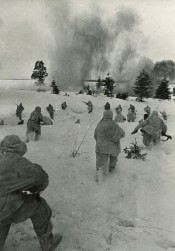
Day of Military Glory of Russia – The day of the beginning of the counteroffensive of Soviet troops against Nazi troops in the Battle of Moscow (1941)
On December 5, 1941, after intense defensive battles that lasted more than two months, the Soviet Red Army launched a counterattack along the entire frontline near Moscow. This offensive, which ended in April 1942, resulted in the defeat of Army Group Centre's shock troops, marking the first major setback for the Wehrmacht since 1 September 1939 and changing the course of World War II.
The Battle of Moscow started on September 30, 1941 with a German offensive in the Bryansk region, followed by an offensive on October 2nd in the Vyazma area as part of Operation "Typhoon". By October 7th, the Wehrmacht had breached the defenses of Soviet troops and encircled the four armies of the Western and Reserve fronts. Heavy fighting occurred 80-100 kilometers from the capital.
On October 15th, 1941, the State Defence Committee of the USSR issued Resolution No. 801c "On the Evacuation of the Capital of the USSR, Moscow" and on October 20th, by Decree of the State Defense Council of the USSR No. 813, a state of emergency was declared in Moscow and adjacent areas.
Despite the initial success achieved due to the superiority in manpower and equipment, as well as the impetus of the attack, the further advance of the German forces was hindered by the stubborn resistance of the Red Army. This resistance was evident, among other places, on the Mozhaisk defensive line, the main line of defense on the outskirts of Moscow. In the midst of heavy fighting on the front, a military parade was held on Red Square on November 7 to celebrate the XXIV anniversary of the October Revolution. This event not only boosted the morale of Moscow's defenders, but also showed the world the resilience and courage of the Soviet people.
In an attempt to capture Moscow before winter, the German command launched an offensive on November 15. However, gradually, the initiative began to shift to the Red Army. On November 27, the Red Army launched counterattacks against the southern and northern groups of the Wehrmacht in the Kashira area. On November 29, they continued their attacks north of Moscow.
In early December, the 1st Shock Army, 16th Army, and 20th Army began pushing the enemy in areas such as Yakhroma, Krasnaya Polyana, and Kryukov, draining them of blood and breaking their morale. The enemy was forced to abandon its last attempt to break through Moscow.
Favorable circumstances have arisen for the Red Army to launch a counter-offensive. In preparation for this, the headquarters of the Supreme High Command conducted two air operations to gain operational air superiority and also replenished the troops on the Western Front. On October 10, these troops united with the Reserve Front, despite the enemy still having a numerical advantage in terms of manpower and equipment, which was only second to 1.6 times that of aviation.
The counteroffensive began on December 5-6, 1941, in difficult weather conditions - severe frost and deep snow cover. By December 7, Soviet troops pushed back the German shock flanking groups that approached Moscow from the north and south by 100-250 kilometers. In early January 1942, the headquarters of the VGK (the Supreme Command of the Armed Forces of the USSR) set the task of encircling and defeating Army Group Center to formations of the Western strategic direction.
The Red Army was wedged into the German defense at the junction of army groups "Center" and "North". However, due to lack of forces, means, and experience in conducting large-scale offensive operations, this task could not be completed. On April 20, 1942, Western troops reached the Rzhev-Gzhatsk-Kirov-Zhizdra line.
During the counteroffensive near Moscow, Soviet troops inflicted a major defeat on German forces, pushing them back by 150-400 kilometers to the west. This victory liberated the Moscow, Tula, and Ryazan regions, as well as parts of Kalinin, Smolensk, and Oryol. The fighting spanned an area roughly the size of France, but it came at a heavy cost. The Red Army suffered losses of about 937,000 killed and 899,000 wounded, while the enemy's casualties are estimated to be between 500,000 and 700,000.
The first major victory of the Red Army during the Great Patriotic War had a significant impact on the morale, strategy, military-political situation, and international relations. It marked a psychological turning point for soldiers and civilians, as it strengthened their faith in victory and shattered the myth of German invincibility.
The failure of the Barbarossa Blitzkrieg plan cast doubt on the German military's ability to win the war, both among its own leadership and ordinary citizens. Japan and Turkey, impressed by the Soviet victory, decided not to join the war on Germany's side. This victory also improved the international position of the USSR and strengthened the anti-Hitler alliance.
Lit.: Великая Отечественная война 1941–1945 годов: в 12 т. Т. 3. Том третий. Битвы и сражения, изменившие ход войны. М., 2012; Жук Ю. А. Неизвестные страницы битвы за Москву: Крах операции «Тайфун». М., 2008; Макар И. П. Московская битва 1941–42 // Большая российская энциклопедия; Московская битва в хронике фактов и событий. М., 2004; То же [Электронный ресурс]. URL: http://militera.lib.ru/h/moskovskaya_bitva_v_hronike_faktov/index.html; Мягков М. Ю. Вермахт у ворот Москвы, 1941–1942. М., 1999; То же [Электронный ресурс]. URL: http://militera.lib.ru/research/myagkov/index.html; Мягков М. Ю. Битва под Москвой // Вестник МГИМО. 2010. № 2 [Электронный ресурс]. URL: https://cyberleninka.ru/article/n/bitva-pod-moskvoy; Рейнгардт К. Поворот под Москвой. Крах гитлеровской стратегии зимой 1941/42 года. М., 1980; То же [Электронный ресурс]. URL: http://militera.lib.ru/research/reinhardt/index.html/index.html.
Based on the materials of Presidential Library:
Battle near Moscow // Memory of the Great Victory: [digital collection]

